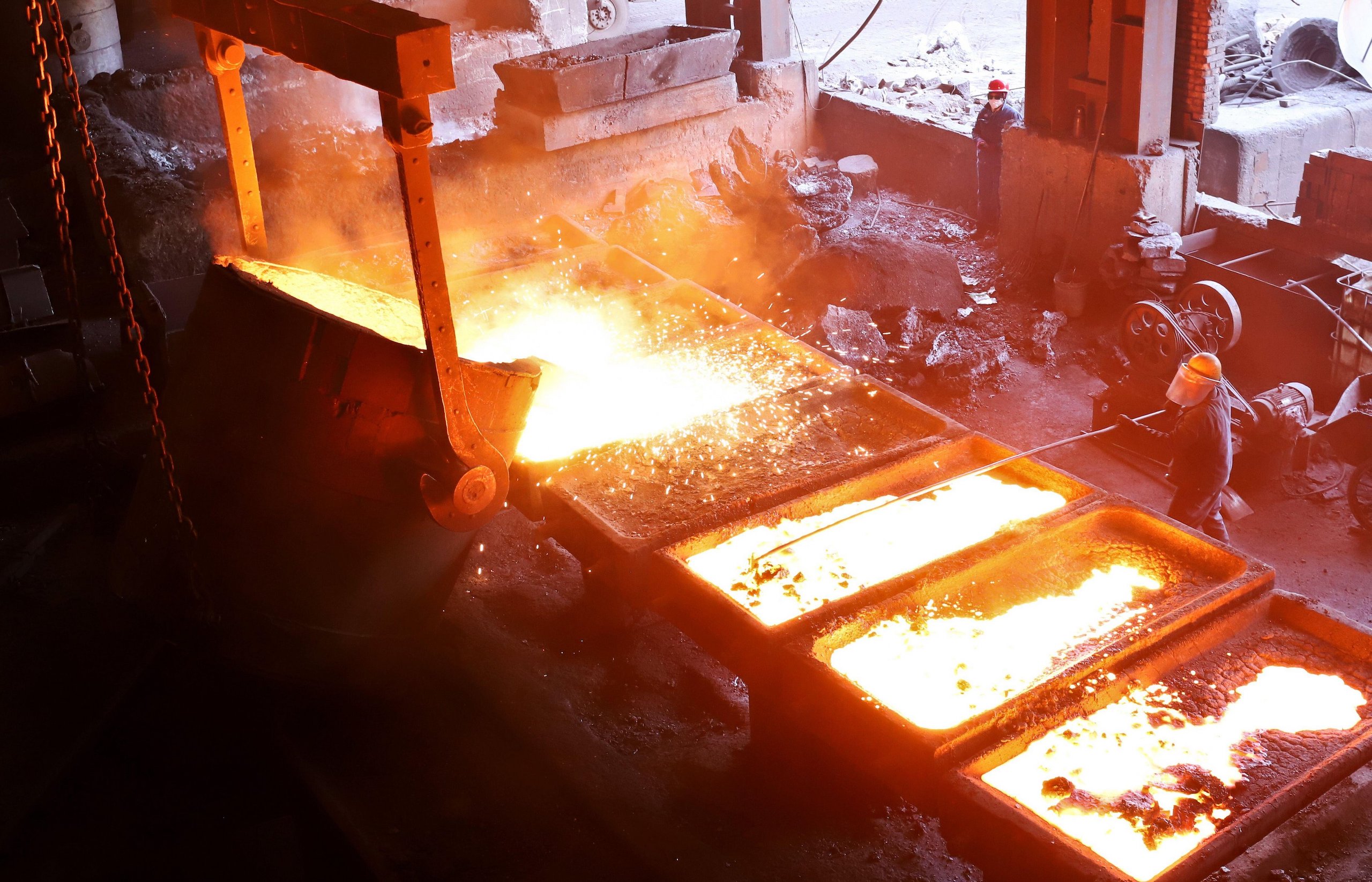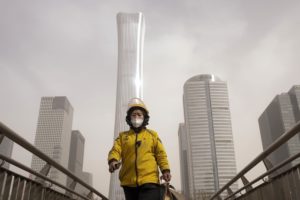A decade of air pollution control has largely restored the blue of Beijing’s skies, but underneath the seemingly clear canopy another form of air pollution is creeping invisibly into the city.
China’s ozone concentration has risen steadily in the first half of this year. On 14 June, 42.4% of cities exceeded the national secondary ozone standard of 160 micrograms per cubic metre (µg/m3), mainly in the Beijing-Tianjin-Hebei and Yangtze River Delta regions. Ozone has overtaken PM2.5 as the top pollutant affecting air quality, particularly in Beijing.
Ground-level ozone pollution occurs when certain chemicals in the air – volatile organic compounds and nitrogen oxides – react in sunlight. These two pollutants come from industrial emissions, car exhaust fumes and the evaporation of organic solvents, such as spray paint. They are closely linked with industries that have both high carbon emissions and high air pollution, often referred to in China as “two high” industries.
This year has seen normal life and economic activity restart after the pandemic lockdowns. While China’s 14th Five Year Plan (for 2021-2025) set targets that would see carbon intensity and total coal consumption fall, the first half of 2023 has seen many provinces take advantage of rules allowing these factors to be ignored when deciding on approvals for “specially designated projects”. This has resulted in approvals being granted to many coal power plants and “two high” projects, which means more industrial emissions. In the future, these extra emissions may worsen ozone pollution and environmental governance challenges.
Ozone now a major pollutant
It has been a decade since China declared war on air pollution, when the State Council published the country’s first overarching, ten-point action plan. That was followed in 2018 with a three-year action plan, focusing on key areas including in and around the Beijing-Tianjin-Hebei region, the Fen and Wei river plains, and the Yangtze Delta. This intensified the fight against air pollution and consolidated existing achievements: average PM2.5 levels fell for ten years in a row, from 72 µg/m3 in 2013 to 29 µg/m3 in late 2022, lower than the World Health Organization’s recommended 35 µg/m3.
Despite such success, another challenge started to emerge. In 2022, ozone overtook PM2.5 to become the biggest contributing factor to air pollution.
Unlike particulate matter, ozone can only be detected with monitoring equipment. It cannot be seen or smelt, which makes it hard to take prompt measures in response to it. However, long-term exposure can trigger respiratory diseases, central nervous system issues, and immune system damage. A study published in March found the number of people in China exposed to excess ozone levels (above the national limit of 160 µg/m3) increased from 1.2% in 2013 to 28.9% in 2018. Furthermore, it concluded that over 20,000 people a year were dying prematurely due to respiratory diseases caused by ozone exposure.
PM2.5 levels dropped 30% during the 13th Five Year Plan period (2016-2020). Ozone, meanwhile, was the only major atmospheric pollutant that didn’t decrease in China. In November 2022, the Ministry of Ecology and Environment published an action plan focused on reducing the number of days of severe air pollution and tackling ozone and diesel truck pollution. This represented a follow-up to the earlier action plans and a landmark in dealing with increasing ozone pollution and occurrences of heavy air pollution in general. Key to that plan was reducing the emission of ozone precursors.
Why is ozone pollution getting worse?
The chemical precursors of ozone are emitted mainly from coal power plants, and industries including steel, glass, and petrochemical processing. China’s nitrogen oxide emissions total about 1.7 times those of volatile organic compounds (VOCs), which means deep cuts in those emissions will curtail the formation of ozone.
In 2021, the power sector was China’s largest source of nitrogen oxide emissions at 33.1%. Most of that came from coal power plants, thereby tying China’s economic growth to polluting industries and growing ozone levels. This situation is being exacerbated by climbing temperatures, caused by climate change.
Ozone pollution has also been a problem in North America. It was first recognised during the 1940s, when Los Angeles experienced photochemical smog. Since the 1970s, the US has invested heavily in understanding how ozone forms and its impact on Los Angeles. Ozone strategies were set for different locations, depending on the make-up of emissions locally. In the case of Los Angeles, there was a shift from the petrochemical industry to a high-tech and service-sector economy. That kind of transition allows for both environmental protection and economic growth, cutting emissions at the source and so significantly reducing ozone pollution.
Elsewhere, the EU’s 2016 directive, “on the reduction of national emissions of certain atmospheric pollutants”, highlights the protection of nature and human health. It calls for investments to shift towards clean and efficient technologies, using innovative methods to tackle pollution at source.
With the economy picking back up following the worst of the pandemic, 2023 has seen year-on-year growth in investment and output in the energy- and carbon-intensive chemical, steel, power and fossil-fuel-processing sectors. That is increasing emissions of nitrogen oxides and VOCs, resulting in air-pollution mitigation faltering in many places in the first half of this year. Between January and June, 339 Chinese cities of prefecture level or above saw a 3.2% year-on-year decrease in the number of days with excellent or good air quality. Conversely, the number of days with heavy or severe pollution went up by 1.4%. These figures correlate with increases in levels of nitrogen dioxide, PM2.5 and PM10 (particulate matter smaller than 10 micrometres in diameter).

Local governments that rely on such investments to boost flagging economies deprioritise environmental concerns accordingly. Industries that contribute to ozone pollution saw steady growth in the first half of this year: the top three industrial emitters of nitrogen oxides (power and heat generation and supply; non-metallic mineral products; and ferrous metal smelting and rolling) grew by 4.1%, 0.4% and 5.5% respectively. The top three industrial sectors for VOC emissions (oil, coal and other fuel processing; chemicals and chemical products; and rubber and plastics) also saw growth. Among them, VOC emissions for raw coal, coke and oil increased by 4.4%, 1.8% and 2.1%, respectively.
Contrary to expectations, profits in these sectors plummeted in the first half of 2023. Extra pollution has not improved the overall economic outlook.
Sectors linked to ozone have seen some of the biggest falls in profits across industry: a drop of 26.6% in the non-metallic mineral products sector; of 97.6% in the ferrous metal smelting and rolling sector; 92.3% in oil, coal and other fuel-processing; 52.2% in chemicals and chemical products profits. Economic growth relying on the “two high” industries is not just environmentally damaging, it also seems set to fail.
Too much “two high”?
Emissions of ozone precursors, nitrogen oxide and VOCs, tend to be found together. Big provincial emitters, including Hebei, Shandong, Guangdong, Jiangsu, Liaoning and Zhejiang, are mostly on China’s east coast. Such locations have grown large industrial sectors, and they have also become key battlegrounds in the fight against air pollution. Despite such concerns, a review of the 14th five-year plans for each of these economies shows many approvals for coal power plants and “two high” projects, using “special designations” that sidestep environmental restrictions.
Several sources say Guangdong and Zhejiang obtained national-level approval for excluding new coal power projects from energy targets. According to rules on how such exemptions work, the environmental impacts of energy consumed by specially designated projects is simply disregarded.
There is more enthusiasm for pursuing glimmers of economic benefits than for tackling ozone pollution
In the 14th five-year plans of both Guangdong and Zhejiang, the petrochemical sector is designated as of strategic importance. Academics have raised concerns that big, new petrochemical projects in Zhejiang will place environmental targets in doubt. Despite this, three phases of the Zhoushan Petrochemical Base project have been approved, pushing the project’s carbon emissions to 50 million tonnes per year; environmental factors have been excluded from local planning decisions.
Furthermore, a 2023 list of Zhejiang’s key projects includes four major petrochemical facilities, with investment totalling 260 billion yuan (US$35.7 billion) – more than half of the total funding allocation for the list. Public information shows that Zhejiang has also requested “special designation” for other “two high” projects, which would once again leave energy consumption disregarded. A 2021 document from the People’s Consultative Conference in Zhejiang’s Ningbo city also called for the removal of energy-consumption quotas, regarding a trillion-yuan green petrochemical cluster. The document also suggests that the cluster could be granted an extra energy-consumption quota, or have its quota shared across the province. Ultimately, it argues that restrictions on approvals for petrochemical projects in Zhejiang should be lifted, because it is one of China’s seven major petrochemical bases.

Solutions at source
The continued approval of “two high” projects by major provincial economies increases the share of heavy industry in the economic mix, pushes pollution and carbon emission peaks higher, and creates extreme economic risks for the future.
This needs to be taken seriously by provincial policymakers. It appears there is more enthusiasm for pursuing glimmers of economic benefits than there is for tackling ozone pollution.
Information reviewed by the Centre for Research on Energy and Clean Air, shows that local governments have simply adopted the national air pollution target to reduce emissions of nitrogen oxides and VOCs by 10% between 2020 and 2025. This is regardless of location-specific emission levels and economic circumstances.
No province has taken the lead by setting itself tougher targets. From industrial provinces like Hebei and Shandong, which have plenty of room to cut emissions, to rich manufacturing provinces such as Zhejiang and Jiangsu, the national target has simply been adopted, or concrete figures are not even provided. This even applies to Shanghai, despite the city setting its target relatively late, in April.
In early summer this year, Hebei used pollution forecasts to restrict the operations of steel and cement makers, power plants, and firms emitting VOCs, when pollution risk was at its highest. Such ad hoc measures can reduce ozone pollution. More importantly, though, is the need to change local industrial structures: key firms must set targets and manage their emissions.
Tackling ozone pollution could be a valuable way for local governments to reduce other forms of pollution and carbon emissions. It is possible to build a more resilient and greener model for development.
Acknowledgements: Thanks for Yao Qintian’s support on researching this article.








